
14 Squadron RNZAF is a squadron of the Royal New Zealand Air Force. In 2015 the squadron was re-raised and equipped with 11 Beechcraft T-6 Texan II. A new aerobatic display team called the Black Falcons was also formed using the new aircraft. They replaced the RNZAF display team known as the Red Checkers.

No. 15 Squadron was a fighter squadron of the Royal New Zealand Air Force that was formed in June 1942. It served in Tonga, Guadalcanal, New Georgia, Espiritu Santo, Bougainville and Green Island. The squadron was equipped with Kittyhawk and, later, F4U Corsair fighters. The squadron was disbanded in October 1945.
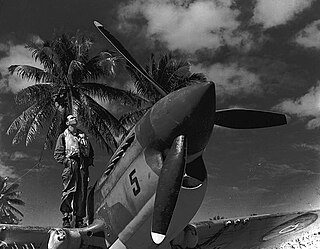
No. 16 Squadron was a fighter squadron of the Royal New Zealand Air Force. Formed in July 1942 at RNZAF Base Woodbourne, the squadron was equipped with Curtiss P-40 Kittyhawks and later F4U Corsairs. The squadron fought in the Southwest Pacific theatre during the Second World War, flying combat operations against Japanese forces. Proposed re-equipment with the P-51 Mustang was abandoned at the cessation of hostilities, and the squadron returned to New Zealand where it was disbanded in October 1945.

No. 25 Squadron of the Royal New Zealand Air Force was formed at Seagrove, Auckland in July 1943 with Douglas SBD Dauntless dive bombers and served in the Southern Pacific based at the Piva Airstrip on Bougainville, flying missions against Japanese forces on Bougainville and at Rabaul. It was disbanded in May 1944 and reformed as a fighter/ground attack squadron flying F4U Corsairs. It served in Santo, Guadalcanal, Los Negros and Emirau, before returning to New Zealand and being disbanded in September 1945. A SBD-4 Dauntless operated by 25 Squadron was for a time preserved in the Royal New Zealand Air Force Museum at Wigram, displayed in the condition which it was recovered after being lost with its crew while on a training mission at Espiritu Santo. One of the SBD-5 aircraft operated by 25 Squadron has been restored to flying condition in America for the "Planes of Fame" museum, in the colour scheme of an American aircraft.
Nissan Island Airport is an airfield serving Nissan Island, in the Autonomous Region of Bougainville in Papua New Guinea. It resides at an elevation of 100 feet (30 m) above mean sea level and has a 1,200-metre (3,937 ft) runway designated 14/32.
No. 9 Squadron RNZAF was a New Zealand bomber reconnaissance squadron in the Pacific Theatre of World War II.
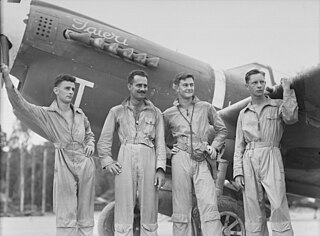
No. 17 Squadron was a fighter squadron of the Royal New Zealand Air Force. Formed in October 1942 at Ohakea, the squadron was initially equipped with Curtiss P-40 Kittyhawks, before converting to F4U-1 Corsairs in 1944. The squadron fought in the Pacific theatre during World War II, flying combat operations against Japanese forces until it was disbanded in late 1945.

No. 26 Squadron RNZAF was a squadron of the Royal New Zealand Air Force. Formed in October 1943, during World War II, from "C Flight", No. 25 Squadron at RNZAF Station Seagrove to be equipped with Douglas SBD Dauntless dive bombers, however was disbanded in January 1944. Reformed in March 1945 at RNZAF Station Ardmore, equipped with Chance-Vought F4U-1 Corsair fighter bombers. The squadron was based at Kukum Field on Guadalcanal and Piva Airfield on Bougainville before being disbanded in June 1945.
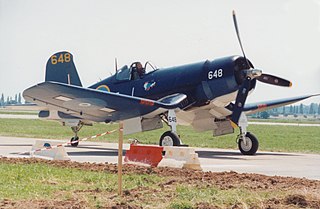
No. 22 Squadron RNZAF was a squadron of the Royal New Zealand Air Force. Formed in August 1942, during World War II, at RNZAF Station Onerahi equipped with the Hawker Hind, co-ordinating with New Zealand Army units providing training for air liaison officers. Reformed on 19 June 1944 at RNZAF Station Ardmore, equipped with Chance-Vought F4U-1 Corsair fighter bombers. The squadron served at airfields in Espiritu Santo, Guadalcanal, Bougainville and Emirau before being disbanded in September 1945.
No. 19 Squadron was a squadron of the Royal New Zealand Air Force. Formed on 10 December 1941 at RNZAF Station Ohakea from members of No. 3 Squadron equipped with P-40 Kittyhawk and later with the Chance-Vought F4U-1 Corsair fighter bombers.
Piva Airfield is a former World War II airfield on Bougainville Island in the Solomon Islands archipelago.
No. 20 Squadron was a squadron of the Royal New Zealand Air Force. It was first established at as an army co-operation unit, serving in this role between 1942 and 1943. In January 1944, the squadron was reformed as a fighter unit at equipped with P-40 Kittyhawks. It later flew F4U-1 Corsair fighter bombers.
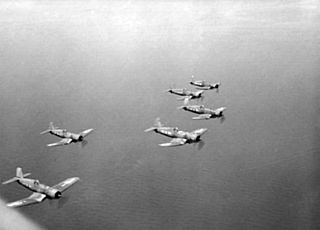
No. 18 Squadron was a squadron of the Royal New Zealand Air Force. Formed in June 1943 at RNZAF Base Woodbourne, the squadron was initially equipped with Curtiss P-40 Kittyhawks, before converting to F4U-1 Corsair fighter bombers in 1944. The squadron fought in the Pacific theatre during World War II, flying combat operations against Japanese forces until it was disbanded in late 1945.
No. 23 Squadron was a squadron of the Royal New Zealand Air Force. It was formed in August 1944 at RNZAF Station Ardmore equipped with the F4U-1 Corsair fighter bomber.
No. 21 Squadron was a squadron of the Royal New Zealand Air Force. Formed in May 1944, it was equipped with F4U-1 Corsair fighter bombers.
No. 31 Squadron is a squadron of the Royal New Zealand Air Force. Formed in December 1943, it was equipped with Grumman TBF Avenger Torpedo bombers.
Ondonga Airfield is a former World War II airfield on New Georgia in the Solomon Islands archipelago.

Michael James Herrick, was a New Zealand flying ace of the Royal Air Force (RAF) during the Second World War. He is credited with having shot down at least six enemy aircraft.
No. 62 Squadron RNZAF was a radar squadron of the Royal New Zealand Air Force during the Second World War. The squadron was formed at Guadalcanal in August 1943 and comprised all the RNZAF radar units sent overseas. The Squadron was disbanded in October 1944.
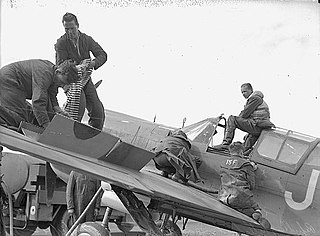
Percival Guy Haig Newton, was a flying ace of the Royal New Zealand Air Force (RNZAF) during the Second World War. He was credited with the destruction of at least five enemy aircraft.









